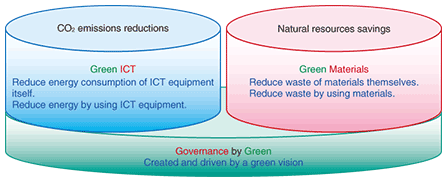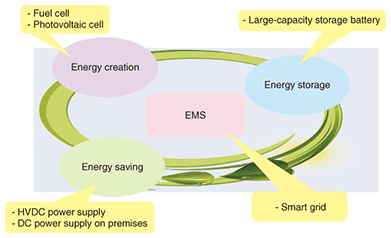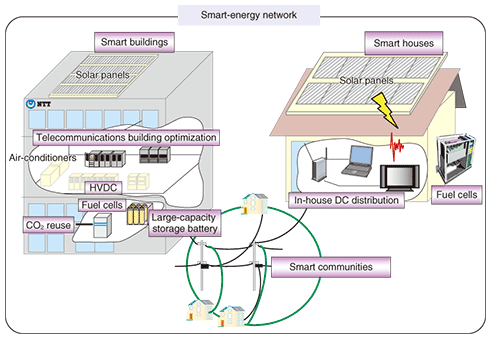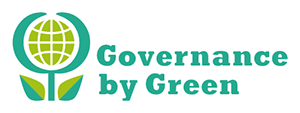 |
|||||||||||||
|
|
|||||||||||||
|
Feature Articles: Environment and Energy Technologies Toward a Green Society Vol. 9, No. 2, pp. 7–12, Feb. 2011. https://doi.org/10.53829/ntr201102fa1 Environment and Energy Technologies Toward a Green SocietyAbstractThis article provides an overview of NTT Energy and Environment Systems Laboratories’ research and development (R&D) objectives and initiatives to move the country toward a green society. Our ambitious R&D agenda is based on three key concepts—Green ICT, Green materials, and Governance by Green—with the goal of completely eliminating CO2 emissions and waste generated by the NTT Group’s business activities by the year 2050.
1. IntroductionCountries all over the world are stepping up efforts to reduce greenhouse gas (GHG) emissions following the onset of the Kyoto Protocol’s first commitment period in 2008. Japan is also moving aggressively to reduce global warming with recent revisions to its Law Concerning the Promotion of Measures to Cope with Global Warming, Law Concerning the Rational Use of Energy, Tokyo Metropolitan Ordinance on Environmental Preservation, and other statutes. The research and development (R&D) work of NTT Energy and Environment Systems Laboratories is helping mitigate global warming and move us toward a zero-waste society by reducing CO2 emissions and saving natural resources associated with the NTT Group’s business activities. 2. R&D policies of NTT Energy and Environment Systems LaboratoriesCommitted to a vision of creating technologies that will steadily reduce CO2 emissions and make the NTT Group into a zero-waste company by the year 2050, NTT Energy and Environment Systems Laboratories is pushing ahead with three basic R&D objectives: Green ICT to reduce CO2 emissions, Green Materials to save natural resources, and Governance by Green to promote environmental management (Fig. 1).
Green ICT is the concept of technologies for reducing CO2 emissions of and by information and communications technology (ICT). It has two aspects: Green of ICT seeking to reduce the environmental impact of ICT equipment itself and Green by ICT seeking to reduce the environmental impact on society by utilizing ICT services. Green Materials is the concept of technologies for saving natural resources that will impose minimal environmental loads and reduce waste disposal costs. Green Materials similarly has two aspects: Green of Materials seeking to reduce waste of materials themselves and Green by Materials seeking to reduce waste by exploiting the functional properties of materials. Governance by Green is the concept of leading the way through the activities of the NTT Group and NTT R&D to CO2 emissions reductions and natural resources savings. These concepts are based upon our belief that no matter how good the performance of the products and services provided by the NTT Group, customers will not be really satisfied with them unless they are eco-friendly. The main R&D themes being addressed by NTT Energy and Environment Systems Laboratories are overviewed in Fig. 2. These themes reflect our core competencies in the following areas.
These technologies are described in detail in the other Feature Articles in this issue. Here, I merely outline some of the main research initiatives related to the three R&D concepts: Green ICT, Green Materials, and Green by Governance. 3. R&D to reduce CO2 emissions (Green ICT)As illustrated in Fig. 3, Green ICT helps reduce CO2 emissions through a medium-to-long-term commitment to energy-saving technologies, energy-creating technologies, energy-storing technologies, and an energy management system (EMS) for controlling and fully exploiting these technologies.
3.1 Energy-saving technologiesEnergy-saving technologies encompass a wide range of equipment and systems designed to reduce the energy requirements of ICT equipment itself, enhance the efficiency of power supply systems, and reduce the energy demands of air conditioners and other facilities closely associated with ICT equipment. One energy-saving technology under development at NTT Energy and Environment Systems Laboratories is a higher-voltage direct current (HVDC) power supply system [1]. Replacing alternating current (AC) supplies with DC supplies in datacenters and other facilities reduces power losses by approximately 15% since fewer power conversion steps are involved. Moreover, stepping up the voltage means that a lower current can supply the required power, which permits the use of smaller diameter cables. This represents a double win: energy is saved and less copper is used in the cables. We are also working on an energy-thrifty customer-premises DC power supply system for deployment in households [2]. 3.2 Energy-creating technologiesEnergy-creating technologies can generate low-carbon clean energy. One project currently under way at NTT Energy and Environment Systems Laboratories is a collaborative effort to produce a high-efficiency solid oxide fuel cell (SOFC). The SOFC is expected to yield an enormous increase in power generating efficiency to over 50% in power generating efficiency [3]. Another project exploits a characteristic feature of fuel cells by recovering and reusing the pure CO2 emitted from the cells. 3.3 Energy-storing technologiesEnergy-storing technologies are essential to safeguard the reliability of communications networks by providing a backup power source in the event that the main power source fails. In this area, NTT Energy and Environment Systems Laboratories is working on a large-capacity storage battery for communications that reduces the footprint of the backup power system, is cost-effective, and has a very long operating life. 3.4 Energy management systemWhile pursuing research on energy-saving, -creating, and -storing technologies, we must maintain optimum control over these technologies. This is done by the EMS (Fig. 3). NTT Energy and Environment Systems Laboratories has focused on the control of distributed power sources by ICT and on developing a smart energy network that maintains an optimal balance between supply and demand for electrical power. A schematic of a smart energy network encompassing smart buildings, smart houses, and smart communities based on technologies developed by NTT Energy and Environment Systems Laboratories is shown in Fig. 4.
This field is showing increasing promise, so we have been pouring more resources and effort into this technology. 4. R&D to save natural resources (Green Materials)As shown in Fig. 5, NTT Energy and Environment Systems Laboratories has stepped up resource-saving Green Materials efforts with emphasis on (1) lifetime-control technologies that extend the useful service life of natural resources as long as possible and (2) recycling technologies that promote reuse of value-added materials.
NTT Group discards close to 300,000 tons of obsolete telecommunications equipment every year. The sheer volume of waste strains the capacity of landfills and has other adverse effects on the environment, not to mention disassembly and processing costs. NTT Energy and Environment Systems Laboratories is pursuing R&D of various technologies to extend the useful service life of products and materials. This includes investigating the deterioration mechanisms of materials and technologies to extend the life of materials and developing diagnostic tools for visualizing corrosion caused by marine environments (salt damage) and other adverse conditions [4]. Moreover, we are trying to establish design-for-zero-waste and recycling technologies with the goal of minimizing the use of natural resources in telecommunications equipment throughout its life cycle. 5. R&D to promote environmental initiatives (Governance by Green)NTT Energy and Environment Systems Laboratories is working to develop a way of quantifying environmental load reduction effects by utilizing ICT (Green by ICT) as one activity in Governance by Green. Green by ICT requires some quantifiable and objective means of assessing how effective ICT services are at reducing CO2 emissions. Once users become aware of the environmentally friendly nature of ICT services, this should enhance the popularity and the competitiveness of ICT services. While seeking to establish techniques for assessing the environmental impact of ICT services, NTT Energy and Environment Systems Laboratories is promoting the NTT Group’s Solution Eco Label [5] system and other group environmental measures and strongly supports the adoption of these practices as international standards. 6. Future prospectsThis article provided an overview of NTT Energy and Environment Systems Laboratories’ R&D objectives and initiatives. Considering how NTT addresses environmental issues in a way that cuts across the NTT Group as a whole as well as NTT R&D, collaboration and cooperation among society at large, NTT Group companies, and other research institutes will become increasingly important in the years ahead. We created the Governance by Green logo shown in Fig. 6 to represent the NTT Group’s commitment to environmental research and the tremendous role this research plays in addressing the environmental challenges of today. While maintaining open dialog and working in line with public interests, NTT Group companies, and other NTT R&D laboratories, we plan to step up our commitment to R&D in the fields of energy and the environment to help bring about the green society.
References
|
|||||||||||||














